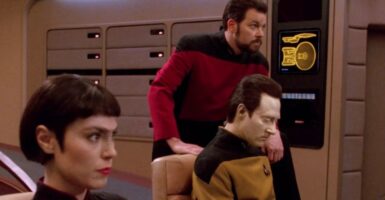NASA’s New Spacesuit Prototype Will Take You To Infinity And Beyond
This article is more than 2 years old

There’s been an ongoing back-and-forth conversation between real-life science and science fiction for decades. Star Trek gave us communicators, and we eventually got flip-open cell phones that looked an awful lot like them. During the run of Babylon 5, creator J. Michael Straczynski fielded inquiries from NASA scientists interested in someday using the design of the show’s Starfury fighters as the basis of real-life cargo loader craft. Now NASA has released a first look at their new spacesuit design, and it leaves you wondering: Just how many times have they watched Toy Story?
Dubbed the “Z-1,” the prototype was developed under the AES suit project, which is working to have a new “vacuum-compatible” suit design ready for use by no later than 2015. The Z-1 is described as a “soft exploration extravehicular activity (EVA) suit configuration.” As explained by Spacesuit Engineer Kate Mitchell, that means most of the Z-1 is made up of “pliable fabrics when unpressurized.” The Z-1 — and whatever iterations follow it until they settle on a final design — will be the first new spacesuit design for NASA since the 1992 introduction of the current EMU (Extravehicular Mobility Unit). There’s no word if the Buzz Lightyear dome and color scheme was intentional, and so far Star Command isn’t returning our calls.
The “Z-1 Prototype Spacesuit and Portable Life Support System (PLSS) 2.0” is designed to be a lot easier to climb into, which I’m sure is a big selling point for any future astronauts. According to the story in the Daily Mail, the current suits can take “an hour” to get into, which is a real drag if you’re trying to swiftly gear up so you can blast a xenomorph out the airlock. It will also be more flexible, more efficient at cooling and removing carbon dioxide, and will have a backpack element that can double as a hatch to allow the astronaut to “dock” with a spacecraft or other vehicle.

The new suit could theoretically be used on eventual missions back to the Moon or on to Mars, but at this point it isn’t being targeted for any specific mission. As such, the suit needs to be designed to handle multiple different possibilities. As Amy Ross, lead of the Space Suit Assembly Technology Development team, joked, “It’s like you’re trying to go on vacation, but you don’t know if you’re going to Antarctica, Miami, or Buckingham Palace.”












